Using Touch-Up Paint
by Ivan RajicHere’s a tutorial I have been meaning to write for a while now. It’s very simple but something that a lot of readers inquire about. Paint chips are normal and part of car ownership, but a lot can be done to fix, improve or prevent even them. I always recommend to clients the installation of a paint protection film (PPF), especially on a brand new car or a newer car that has no chips or no noticeable chips. With the newer film technologies available these days, the film barely shows on most vehicles even when cut at 1/3 or 1/2 way up the hood and fenders. However, most vehicles out there don’t have any sort of film and do suffer almost daily from some paint chips. On this particular vehicle, there were a few paint chips of decent size that were very distracting on the jet black paint job. Along with a paint correction, the client asked us to fill in the few larger chips simply to improve the look and make them less visible.
My kit of choice is Dr. Colorchip. I find it much better and easier to use than typical touch-up paint mainly because of how it’s applied. Rather than having a thicker consistency and leaving blobs, for the lack of a better word, on the paint, the Dr. Colorchip paint is more like a liquid and simply fills in the chip. Of course the photo I took of the kit was completely out of focus for some reason, but if you go to their website you’ll see exactly what’s included. Basically, you get some OEM matching touch-up paint, blending solution, 2-3 brushes, a cloth, a glove and a microfiber towel. The process is very simple and always easily improves even some larger chips.
In this case, we are focusing on a few chips near the passenger side headlight, which seem to have been caused by a few small stones being thrown up or something quickly rolling over that area. As you can see in the photo below, there are about 4 paint chips of various sizes and depth.
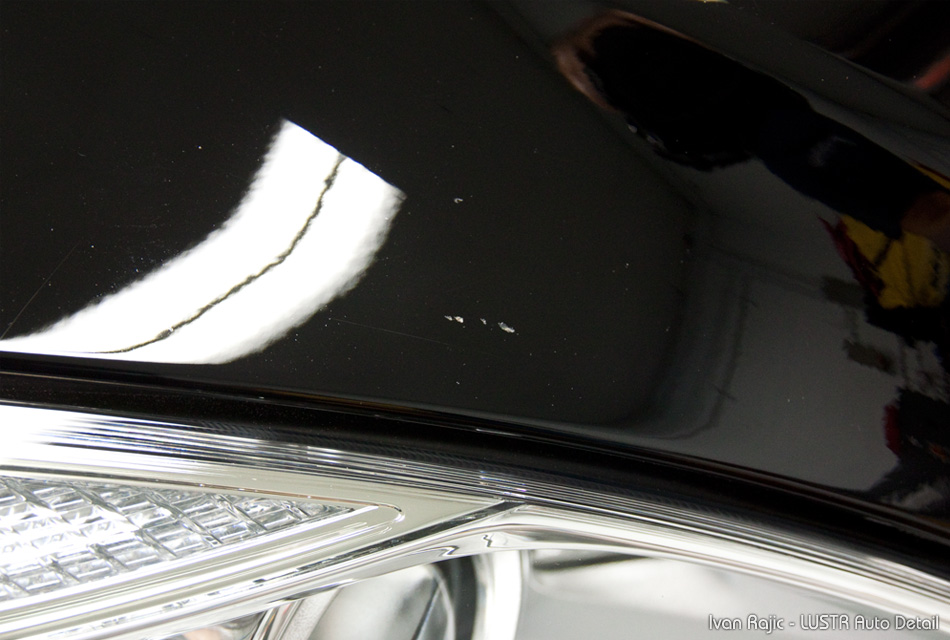
The process starts with using a brush provided with the kit to apply some touch-up paint to the paint chips…
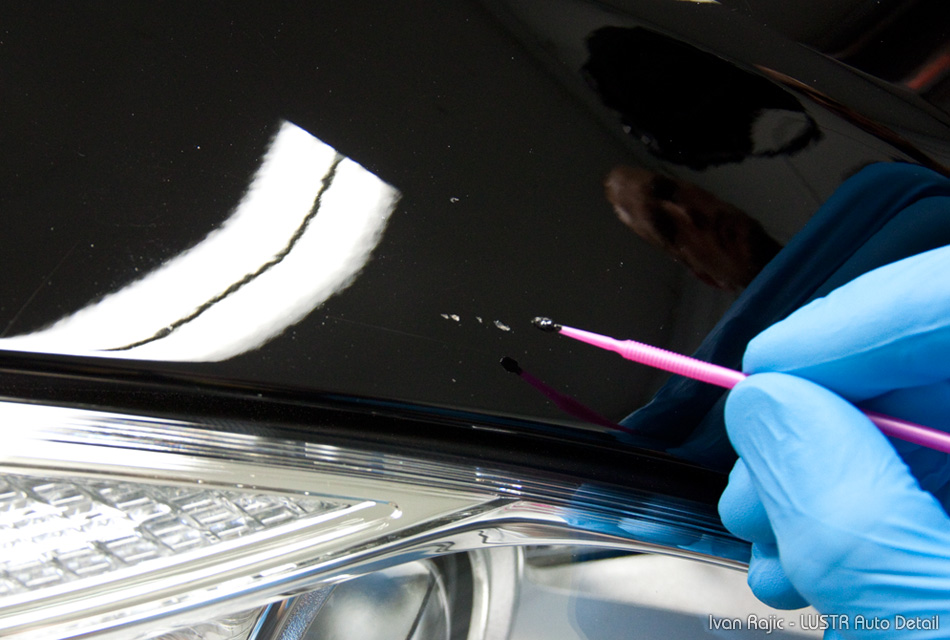
Once applied, it should look like a normal blob of paint sitting on top of the chips…
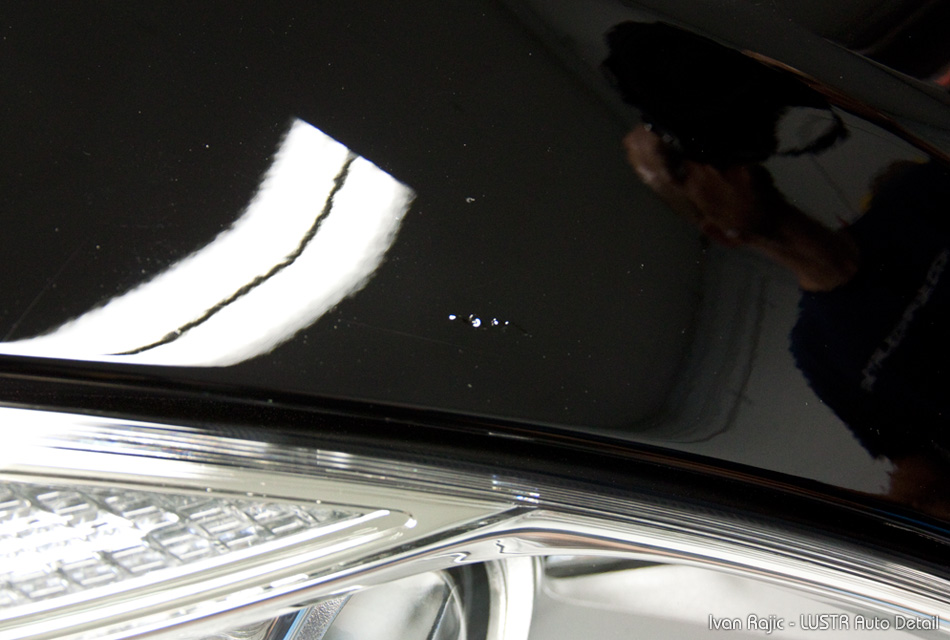
Then you need to smear the paint lightly with your finger in order to spread it out a bit and even the level of the new paint with that of the existing paint around the chips…
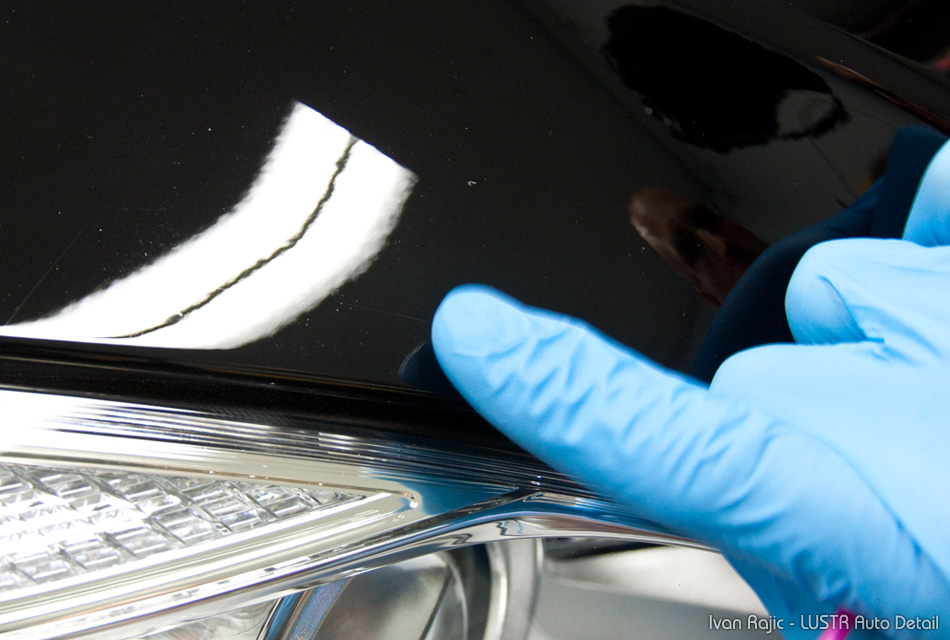
Once this is done, let the paint dry for about 4-5 minutes. As you can see in the photo below, there will be touch-up paint both in the actual chips as well as on top of the existing paint. This is how it should look and something you will take care of in the next step.
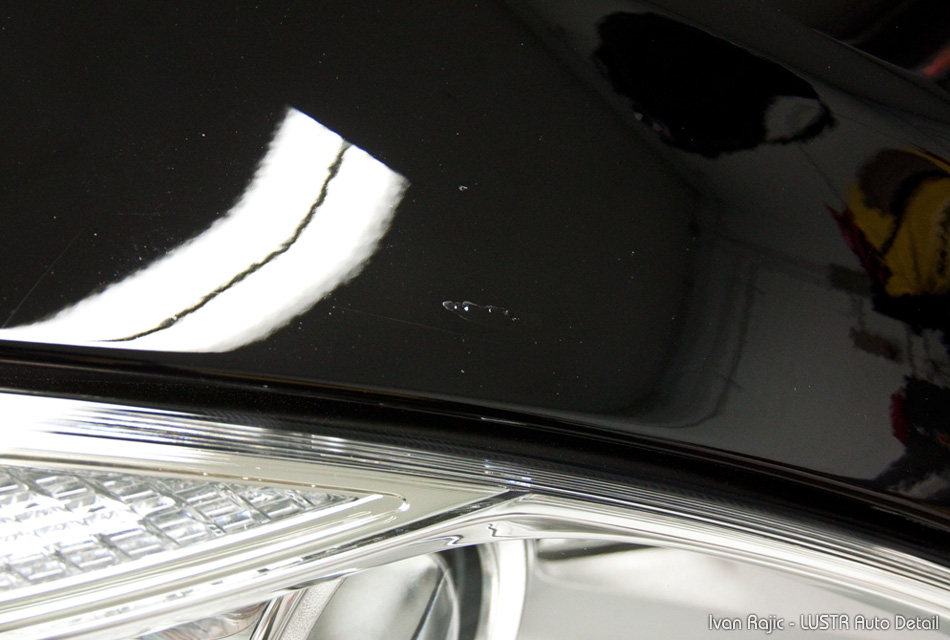
Once about 5 minutes passes, you use their SealAct blending solution (or as I like to call it “mild paint thinner” 🙂 ) with a provided cloth to remove the extra paint around the chips. (Sorry about the out of focus picture here)
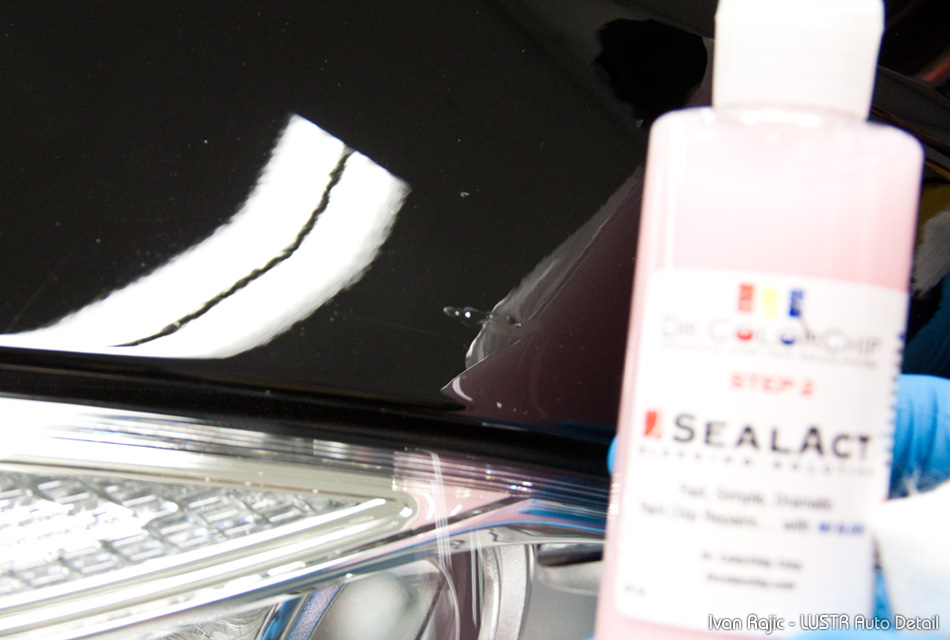
The key here is to use the right amount of solution (start with 2-3 drops and adjust accordingly) and very little to no pressure. You want to slowly remove the extra paint that’s sitting on the original paintwork around the paint chip, without removing much or any of the touch-up paint that’s inside the paint chip. Normally, you will remove some of the paint within the chip as well, but most of it will stay inside to cover the area. This can be improved by using some sort of flat surface instead of your finger to press the cloth onto the paint while gliding across, as it will stay out of the actual paint chip much more.
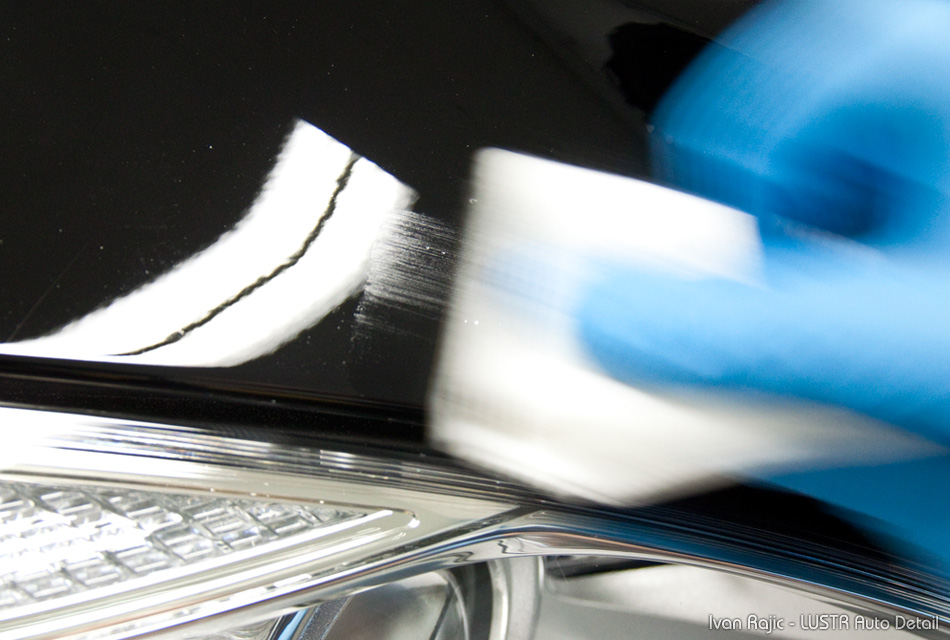
Once done, the paint chips should now be filled in with the colored paint and a lot less noticeable. The photos here all show results from only one touch-up process, but I would highly recommend doing it 2-4 times to make sure the paint chips get filled really well and improved as best as possible.
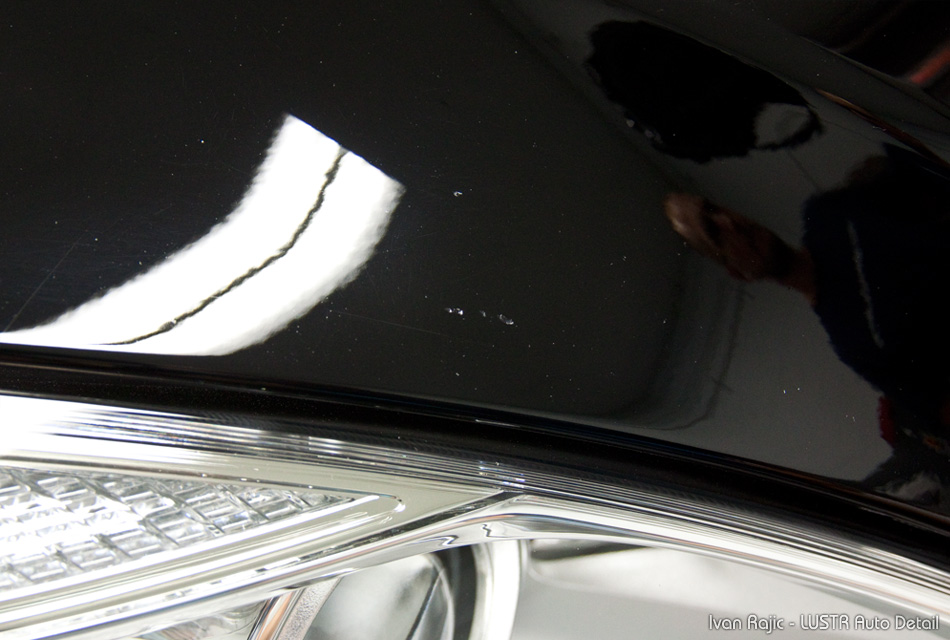
In the photo below, I copied a section of the “after” photo above the “before” to show the difference in paint chips. As you can see, the filled in paint chips look a lot better and are not as noticeable anymore. Keep in mind, in the photos here the light is directly reflecting off the touch-up paint, so the actual paint chips look a lot better in person than they do in the photo.

Again, this is a very simple process that can be easily repeated a few times to improve the results. The touch-up system works really well on paint chips and scratches, so it can be a very useful tool when offering a service to certain clients. I recommend doing this before any finish polishing if at all possible as you’ll have to marr up the paint a bit when removing the extra paint from around the paint chip.
All in all, it’s a very simple process and I hope this quick tutorial is a help for some barely getting used to it. Thanks as always for reading and please feel free to post any questions or comments below.









Thanks for the article, Ivan. One question that I have before I try to work on some chips on my black G37S. Does the area need to be completely stripped of wax and sealants prior to using the kit? If so, what would you recommend?
Definitely Steven. Isopropyl alcohol is good but a good wax and grease remover is best. I would consult with a local body shop or auto parts store on what’s best, but from what I know Klean-Strip Prep-All is a very good product.
I’ve used Dr Colorchip with mixed results. On pinhead sized chips it worked pretty well after a few tries.. On anything like a match head sized chip, the metallic paint doesn’t work as well and almost appears a solid color instead of metallic. Forget any success on anything larger than a match head. I also found that the amount of “blender” thinner is insufficient for the amount of paint supplied. I see now the supply a stiff card to use with the blender and rag instead of just a rag. This is an old trick that they finally picked up on. Also very overpriced but with a couple new competitors on the market, that should affect the cost. One competitor is offering a buy one get a 2nd color free for less than the cost of one Mr. Colorchip. One of my friends tried it and it seemed to easily work and equally as well.
What product did they use? I have a tiny chip and looking to fix it and don’t know what to use was gonna try the dMr colorchip
I used Dr. Colorchip to repair a few chips on my 2006 Pontiac Solstice. They color is Aggressive which is a very bright red. While I thought the kit was overpriced, I got very good results. So good, in fact, that a buddy I showed the chips to before I made the repair had a difficult time finding the spot again after the repair. Since I worked on it, I could go right to the spot of the repair. However, I think I would have trouble finding it if it weren’t my car. It has made the chip very much less noticeable.
Don’t dab in the middle of a chip, poke at the rim, swipe it with your finger once to level and fill in and move on cuz you got another dozen chips to go…..
Thanks for the info Ivan. But is the method the same for Pearlescent, as I seem to have a matt finish even after polishing.
Hi. I was hoping you cud advise me as to what is my best method to restoring, polishing & protection for my paintwork & alloy wheels. I usually just use auto glym but I felt I need something else to protect it & my auto glym has gone very thin & watery so it needs replacing! I like the Bilt Hamber double speed wax that you sell. I’m thinking of using T-cutetallic, not the usual T-cut, a T-cut for metallic surfaces (less abrasive I guess). I believe that I would apply the metallic T-cut, then apply auto glym super resin polish & then the Bilt Hamber double speed wax to seal & protect. I like what I hear about this product but I’ve never used wax before, only auto glym after a meguiars gold class shampoo wash. Can u advise me if I am correct in my method & how to go about using all 3 but especially the Bilt Hamber? Also your recommendation for some quality cloths to apply the products? (do I need different types of cloths for each product). My car is a 2004 Audi A3 in Akoya Silver (clear coat lacquer) & the paintwork is in excellent condition for a 12 year old car but I feel I need more protection before the paintwork starts to show it’s age!
I have been trying for years to get a satisfactory result with touch up paints. Even if the color appears to be the same while the paint is in the bottle, when I apply the paint to the car the match with the existing paint looks terrible. It stands out from a mile away, and does not blend in what-so-ever with the color I’m trying to match. What’s worse, is the fact that the paint level is not the same, making it stand out more. If the paint applied is larger than a match head, there’s no use in applying it. It would be better to have the body part (with me it’s usually the hood) repainted. It’s an expensive pain in the you know where, but it’s a real downer to look at splotches of unmatching paint on you hood and elsewhere.
Very useful guidance for cartouches up paints with full details.